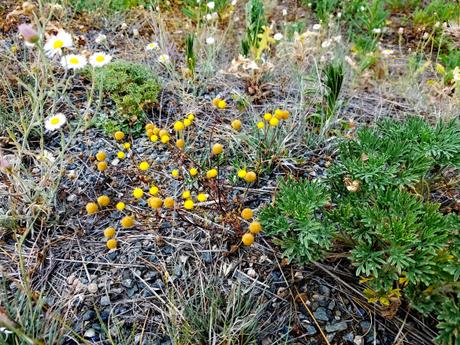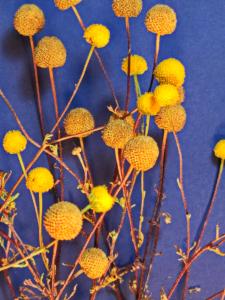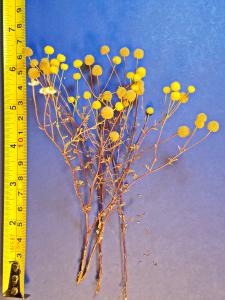Stinknet Has Reached Dewey-Humboldt, Arizona
Yesterday (June 14, 2019), I discovered a new invasive weed growing in Humboldt. The plant’s small yellow flowers caught my attention as I walked along Old Black Canyon Highway. Roads are common dispersal routes for invading weeds. First the roadsides, next the yards and hillsides.

Stinknet (Oncosiphon piluliferum), an invasive desert weed.
The first thought produced by Stinknet is that its bright yellow flowers are beautiful. The next thought, however, is that something stinks. Stinknet produces resinous sap that smells like a rotten pineapple. The odor plus the tendency for the plants to grow in tight formation create real impediments to outdoor activity. Even worse, Stinknet is a strong competitor that replaces native plants. But worse still, the plants are highly flammable and encourage destructive wildfires. If Stinknet invades, the quality of natural habitats will decline and many soil organisms, native plants, and native animals will disappear.
Stinknet is spreading across the hot deserts of California and Arizona. I’ve known about the weed since 2008 when Andrew Salywon of the Phoenix Botanical Garden ranked it as one of four weeds posing the greatest threats to Agua Fria National Monument 20mi south of Humboldt. The plant has not been reported above 2300ft in Arizona, and I assumed that at 4500ft, Lonesome Valley winters would be too cold for Stinknet. I did not even include it in the list of possible future weeds in Weeds of Dewey-Humboldt, Arizona. Let’s hope that other dangerous weeds that I did not list will not reach Lonesome Valley.

Stinknet is a member of the Sunflower family. It’s small round yellow flower heads are composed of 100 to 250 flowers packed into a ball no more than 1cm (1/2in) in diameter (Copyright 2019, Garry Rogers).

Stinknet is a small plant rarely more than 2ft tall. This plant is about 6 1/2in (Copyright 2019, Garry Rogers).
Treatment: How to Control Stinknet
Though people have carried Stinknet thousands of miles from its South African home, and though the plant has dispersed rapidly along Arizona highways, Stinknet may not survive and spread in Dewey-Humboldt. However, that’s not a safe bet. Like medical doctors, weed professionals practice EDRR (Early Detection Rapid Response). Now’s the time to begin watching for the plant along the highway and town streets. At this early point in Stinknet’s invasion of Dewey-Humboldt, the best control tactic is pulling and bagging the complete plant including the roots. If the plant spreads, control will become much more difficult and expensive. Like any disease, weed invasions are easier to cure when discovered early.

Stinknet (Copyright Max Licher).
Identification
Stinknet (Oncosiphon piluliferum) Daisy Family—ASTERACEAE.
Annual with persistent roots. Small, less than 2ft tall. One to five or more thin stems arising from base, sparse alternate leaves, striking yellow flowers in small tight balls less than 10mm diameter. Stinky.

